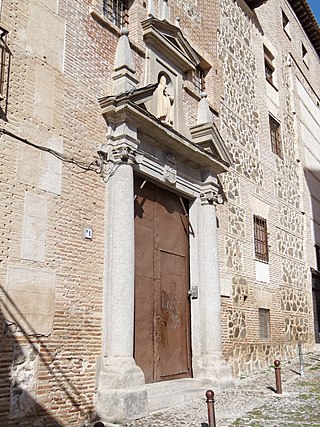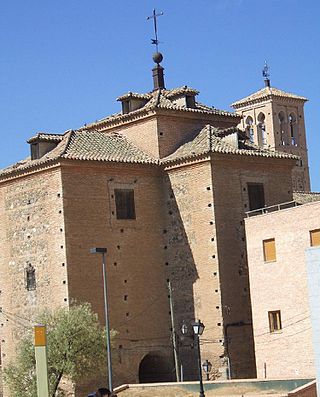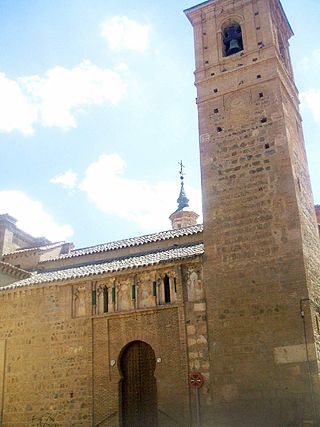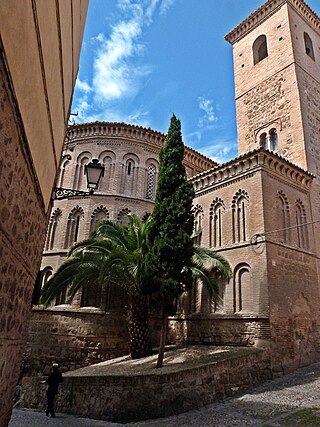
The monumental complex of the Basilica and Convent of San Francisco of Lima, also known as "San Francisco el Grande" or "San Francisco de Jesús", is located in the Historic Center of Lima, Peru. This church together with the Sanctuary Nuestra Señora de la Soledad and the Church del Milagro set up one of the welcoming and artistic corners of Lima. Ramón Menéndez Pidal, Spanish philologist and scholar in this regard commented: "It is the largest and noblest monument that the conquest erected in these prodigious lands".

Llerena is a municipality located in the province of Badajoz, Extremadura, Spain. According to the 2007 census (INE), the municipality had a population of 5,995 inhabitants. Llerena, a town that declared itself a Historical Artistic gathering on December 29, 1966, is located in southwestern Spain. The head of the judicial and economic center of the region of the country of the same name, it is equidistant from 20 municipalities, and sits at the confluence of the District 432 and 413 National Roads.

The Iglesia de San Román is a church in Toledo. The church was built in the Mudéjar style in the 13th century. On this site there was an old Visigothic structure and probably an ancient Roman building.

The Monastery of Saint Dominic of Silos (the Old) (Spanish: Monasterio de Santo Domingo de Silos (el Antiguo)) is a Cistercian convent in Toledo, Spain.

The Iglesia de Santo Tomé is a church located in the historical center of the city of Toledo (Spain), and was founded after the reconquest of this city by King Alfonso VI of León. It appears quoted in the 12th century, as constructed on the site of an old mosque of the 11th century. This mosque, together with other mosques in the city, were used as Christian churches without major changes, since in the taking of the city there was no destruction of buildings.

The Tower of San Cristóbal is a Mudéjar tower belonging to the Church of San Cristóbal in Toledo (Spain).

The Convento de San Clemente is a Renaissance convent located in the city of Toledo, in Castile-La Mancha, Spain. It was founded in the 13th century during the reign of Alfonso X of Castile the Wise. Inside the building there are a Roman cistern, Mudéjar architecture, remains of the Palacio de los Cervatos and many decorative elements.

The Agustinas Ermitañas Convento Santa Úrsula is an Augustinian convent located in the city of Toledo, in Castile-La Mancha, Spain. It was founded in 1259.

The Iglesia de San Miguel el Alto is a building of medieval origin located in Toledo. Dedicated to St Michael, the church served one of the old Latin parishes of the city, but is now part of the parish of San Justo. It appears that it also had some relation to the Knights Templar who are believed to have had a guest-house in Toledo.

The Church of San Andrés is a Catholic church located in the city of Toledo, in Castile-La Mancha, Spain. The building is of medieval origin, and as is common in this city, is a mix of different styles. It is protected by the heritage listing Bien de Interés Cultural.

The Church of San Bartolomé is a medieval building in Toledo, in Castile-La Mancha, Spain. It is located in the southern part of the walled city, at the corner of calle San Bartolomé and calle Cristo de la Para, a few hundred meters south-west of the Cathedral of Santa María.

The Iglesia de San Vicente is a medieval church located in Toledo, it appears as a parish already in 1125, although, there is documentation that speaks of its being founded by Alfonso VI shortly after his conquest of the city in 1085.

The Church of St Leocadia is a medieval church located in Toledo, in Castile-La Mancha, Spain.

The Iglesia de los Santos Justo y Pastor, popularly known as Iglesia de San Justo, is a church located in the city of Toledo. It was founded after the city was taken by King Alfonso VI of León and Castile in the 13th century. The city underwent transformations between the 14th and 18th centuries. This is a religious temple under the invocation of the holy children Justus and Pastor.

The Convento de la Madre de Dios is a Dominican convent located in the city of Toledo. It was founded at the end of the 15th century as a nunnery by Leonor and María de Silva, daughters of the Count of Cifuentes. It was a cloistered monastery, a Guardia Civil barracks, and finally a university campus after its acquisition by the University of Castilla-La Mancha to expand the facilities of the Faculty of Juridical and Social Sciences.

The Convento de San Antonio de Padua is a Franciscan convent located in Toledo, Castile-La Mancha, Spain. Dedicated to St Anthony of Padua, the institution was created in 1525 in the former palace of the advisor comunero Don Fernando de Ávalos, confiscated by order of Charles V, Holy Roman Emperor because its owner was a comunero. The entrance is Gothic-Mudéjar of the 15th century.

The Convento de Santa Isabel de los Reyes is a convent located in the city of Toledo, in Castile-La Mancha, Spain. The current convent, founded in 1477 by Doña María Suárez de Toledo, known as "Sor María la Pobre", has its origins in two different palaces, both Mudéjar from the 14th century and the church of San Antolín.

The Convento de San Pedro Mártir is a convent located in Toledo, Spain. The Dominican convent was moved in 1407 from its location outside the walls to the houses donated by Doña Guiomar de Meneses. through its successive extensions and modifications, became one of the richest and most important convents of the city.

The Convento de la Purísima Concepción, also called Convento de Capuchinas, is a convent located in the city of Toledo, in Castile-La Mancha, Spain.

Old Town of Cáceres is a historic walled city in Cáceres, Spain.






















